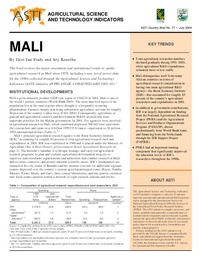Authors:
Stads, Gert-Jan; Kouriba, Aly
Year:
2004
Publisher
International Food Policy Research Institute (IFPRI); and Rural Economy Institute (IER)
Back to:
Since the beginning of the 1990s, agricultural researcher numbers have gradually fallen in Mali, but agricultural spending has remained stable, mainly as a result of the continuously adequate levels of donor funding.
During 1991–2001, IER was strongly dependent on two donor projects: PNRA—funded by World Bank loans, counterpart funding from the Government of Mali and IER itself, as well as various foreign donors—and PAPIER—funded by the Dutch government. These projects have brought important institutional changes to IER and have considerably improved the quality of its research programs. PNRA was immediately followed by another World Bank project: PASAOP. This project is currently in its first phase (of three), and despite its unsound start, the project’s principal objectives are expected to be reached, and the second and third phases of the project are likely to be implemented, securing stable funding for IER and LCV in the years to come.
During 1991–2001, Malian agricultural research was characterized by a significant improvement of the education levels of researchers and efficient operation in regional and international partnerships. Mali outperformed its neighbors in many key indicator areas. The country also distinguishes itself from many African countries in having an extremely centralized agricultural research system. One single agency (IER) is responsible for 85 percent of the country’s total agricultural
researchers and expenditures.

